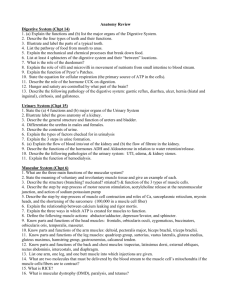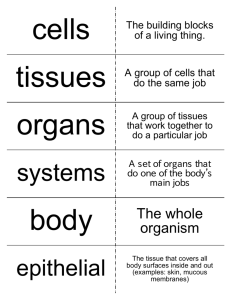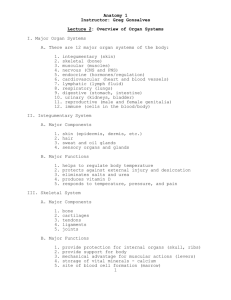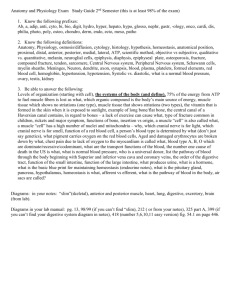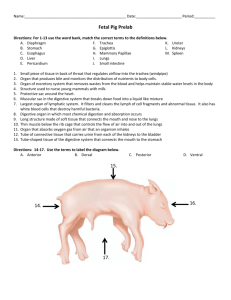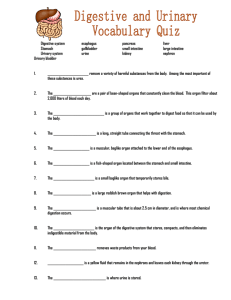0 Human Systems Vocab 2014
advertisement
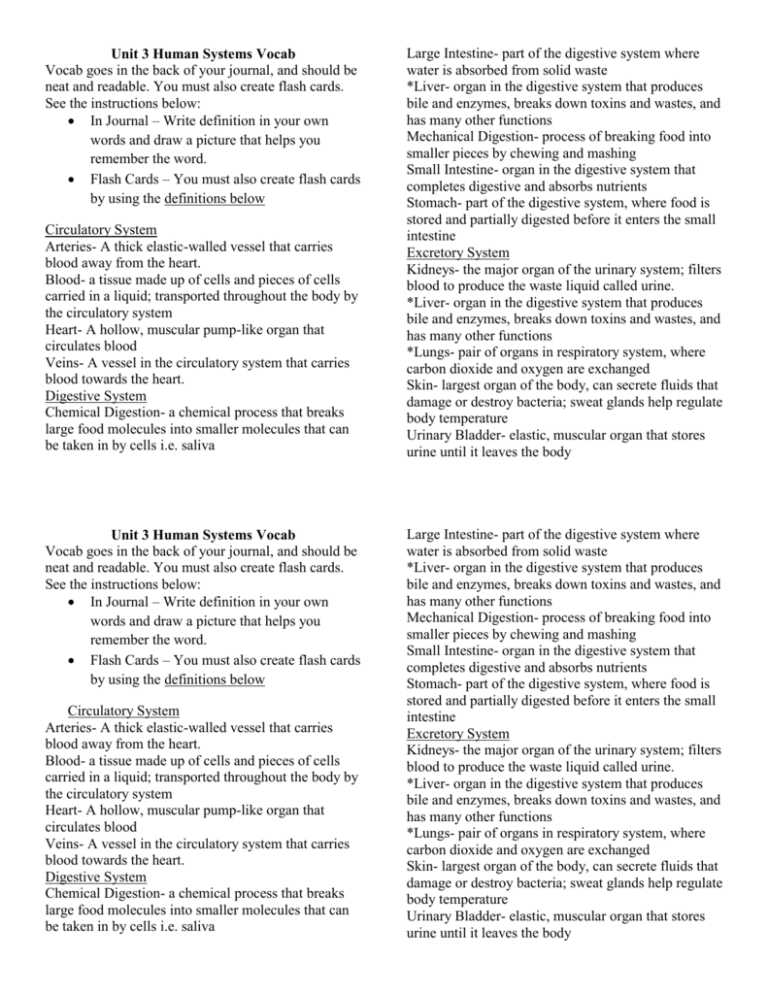
Unit 3 Human Systems Vocab Vocab goes in the back of your journal, and should be neat and readable. You must also create flash cards. See the instructions below: In Journal – Write definition in your own words and draw a picture that helps you remember the word. Flash Cards – You must also create flash cards by using the definitions below Circulatory System Arteries- A thick elastic-walled vessel that carries blood away from the heart. Blood- a tissue made up of cells and pieces of cells carried in a liquid; transported throughout the body by the circulatory system Heart- A hollow, muscular pump-like organ that circulates blood Veins- A vessel in the circulatory system that carries blood towards the heart. Digestive System Chemical Digestion- a chemical process that breaks large food molecules into smaller molecules that can be taken in by cells i.e. saliva Unit 3 Human Systems Vocab Vocab goes in the back of your journal, and should be neat and readable. You must also create flash cards. See the instructions below: In Journal – Write definition in your own words and draw a picture that helps you remember the word. Flash Cards – You must also create flash cards by using the definitions below Circulatory System Arteries- A thick elastic-walled vessel that carries blood away from the heart. Blood- a tissue made up of cells and pieces of cells carried in a liquid; transported throughout the body by the circulatory system Heart- A hollow, muscular pump-like organ that circulates blood Veins- A vessel in the circulatory system that carries blood towards the heart. Digestive System Chemical Digestion- a chemical process that breaks large food molecules into smaller molecules that can be taken in by cells i.e. saliva Large Intestine- part of the digestive system where water is absorbed from solid waste *Liver- organ in the digestive system that produces bile and enzymes, breaks down toxins and wastes, and has many other functions Mechanical Digestion- process of breaking food into smaller pieces by chewing and mashing Small Intestine- organ in the digestive system that completes digestive and absorbs nutrients Stomach- part of the digestive system, where food is stored and partially digested before it enters the small intestine Excretory System Kidneys- the major organ of the urinary system; filters blood to produce the waste liquid called urine. *Liver- organ in the digestive system that produces bile and enzymes, breaks down toxins and wastes, and has many other functions *Lungs- pair of organs in respiratory system, where carbon dioxide and oxygen are exchanged Skin- largest organ of the body, can secrete fluids that damage or destroy bacteria; sweat glands help regulate body temperature Urinary Bladder- elastic, muscular organ that stores urine until it leaves the body Large Intestine- part of the digestive system where water is absorbed from solid waste *Liver- organ in the digestive system that produces bile and enzymes, breaks down toxins and wastes, and has many other functions Mechanical Digestion- process of breaking food into smaller pieces by chewing and mashing Small Intestine- organ in the digestive system that completes digestive and absorbs nutrients Stomach- part of the digestive system, where food is stored and partially digested before it enters the small intestine Excretory System Kidneys- the major organ of the urinary system; filters blood to produce the waste liquid called urine. *Liver- organ in the digestive system that produces bile and enzymes, breaks down toxins and wastes, and has many other functions *Lungs- pair of organs in respiratory system, where carbon dioxide and oxygen are exchanged Skin- largest organ of the body, can secrete fluids that damage or destroy bacteria; sweat glands help regulate body temperature Urinary Bladder- elastic, muscular organ that stores urine until it leaves the body Muscular System Cardiac Muscle- involuntary muscle tissue found only in the heart Involuntary Muscle- a muscle that cannot be consciously controlled, such as heart and digestive muscles Skeletal Muscle- voluntary muscles that work in pairs and move bones Smooth Muscle- involuntary muscles that move many internal organs, such as the stomach, intestines and blood vessels Voluntary Muscle- a muscle you can control, such as arm and leg muscles Nervous System Brain Stem- the part of the brain extending from the cerebrum to the spinal cord; controls and coordinates involuntary muscle movements such as heart beats Central Nervous System- part of the body’s control system, including the brain and spinal cord; sorts and interprets information from stimuli Cerebellum- the part of the brain that coordinates voluntary muscle movements; maintains balance and muscle tone Cerebrum- the part of the brain that interprets impulses from the senses, stores memory, and controls the work of voluntary muscles Neurons- nerve cell that carries impulses throughout the body; the basic unit of the nervous system Peripheral Nervous System- part of the control system, including cranial nerves and spinal nerves that connect the brain and spinal cord to other body parts. Respiratory System Alveoli- tiny air sacs in the lungs where gases are exchanged Bronchi- Two short tubes that branch off the trachea and carry air into the lungs. Diaphragm- A large domed muscle that separates the chest and abdomen and helps move air in and out of the body. *Lungs- pair of organs in respiratory system, where carbon dioxide and oxygen are exchanged Other Enzymes- a protein in the body that helps control a chemical reaction, such as digestion Homeostasis- the regulation of steady, lifemaintaining conditions inside an organism or cell, despite changes in the environment Muscular System Cardiac Muscle- involuntary muscle tissue found only in the heart Involuntary Muscle- a muscle that cannot be consciously controlled, such as heart and digestive muscles Skeletal Muscle- voluntary muscles that work in pairs and move bones Smooth Muscle- involuntary muscles that move many internal organs, such as the stomach, intestines and blood vessels Voluntary Muscle- a muscle you can control, such as arm and leg muscles Nervous System Brain Stem- the part of the brain extending from the cerebrum to the spinal cord; controls and coordinates involuntary muscle movements such as heart beats Central Nervous System- part of the body’s control system, including the brain and spinal cord; sorts and interprets information from stimuli Cerebellum- the part of the brain that coordinates voluntary muscle movements; maintains balance and muscle tone Cerebrum- the part of the brain that interprets impulses from the senses, stores memory, and controls the work of voluntary muscles Neurons- nerve cell that carries impulses throughout the body; the basic unit of the nervous system Peripheral Nervous System- part of the control system, including cranial nerves and spinal nerves that connect the brain and spinal cord to other body parts. Respiratory System Alveoli- tiny air sacs in the lungs where gases are exchanged Bronchi- Two short tubes that branch off the trachea and carry air into the lungs. Diaphragm- A large domed muscle that separates the chest and abdomen and helps move air in and out of the body. *Lungs- pair of organs in respiratory system, where carbon dioxide and oxygen are exchanged Other Enzymes- a protein in the body that helps control a chemical reaction, such as digestion Homeostasis- the regulation of steady, lifemaintaining conditions inside an organism or cell, despite changes in the environment



